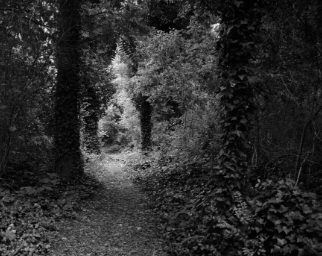Bey’s reflective photographs and films reveal the impact of the past
Despite its minimalistic appearance, Dawoud Bey’s Elegy provides his audience a profound understanding of the grim experiences along the Virginia slave trail, Louisiana plantations, and Ohio’s Underground Railroad.
Consisting of only 42 photos and two films, Bey successfully portrays the everlasting remnants of America’s history, specifically in these three locations. The Virginia Museum of Fine Arts displays Elegy throughout multiple rooms in their lower level, reserved for special exhibits.
The first series, Stony the Road, containing several black and white photographs, displays the views along the familiar James River. Bey’s photos do not clearly show the past; without context, one would glance over the pictures with little thought.
By doing so, Bey emphasizes the connection between the past and the present, indicating how they intertwine.
The next room displays the film 350,000, which consists of one continuous shot along this trail. Taking a first person perspective, the camera stays out of focus with a hazy gradient along the borders.
The view wanders from the leaves on the ground to the trees covering the sky to the rushing water of the James.
In the background, diverse sounds begin to build up as the video progresses. Noises of birds, running water, and rustling branches accompany disgruntled breathing, heavy footsteps, muffled voices, and clinking chains.
As the perspective continues along the path, the sounds build upon each other, creating a chaotic feeling, especially as the breathing increases and muffled voices elevate. Eventually, moans and whimpers join in, evoking feelings of unsettlement.
Despite the film only depicting a seemingly normal trail, Bey emphasizes the lingering presence of the past through the unsettling audio overlaying it. The history of the trail, though invisible to the eye and unknown by many, hovers above those who walk along it.
The second series, In This Here Place, contains photographs of Louisiana plantations, specifically the Evergreen, Destrehan, Laura, Oak Alley, and Whitney. These photos highlight the flourishing sugar cane fields and deteriorating plantation homes, focusing on the contrast between the past and present.
Continuing on, the next room shows a short film composed of three screens titled Evergreen. Taking place at one of the longest lasting chattel slavery plantations, the visuals bring to light a beautiful yet unsettling scene.
Each panel displays a different view, yet all three provide a saturated green landscape with flourishing trees outshining the dull, broken down houses of the plantation. In the background, melodic vocals hum, scream, and whisper, further adding to the disturbing beauty of the scene.
Unlike Stony the Road which blended both the past and present, In This Here Place starkly contrasts the horrors of the location’s history with the beauty of the present. While the surrounding nature thrives, it fails to overpower the horrid remains from the past.
For his final series, Night Coming Tenderly, Black, Bey concludes the exhibit with the final stages along the treacherous Underground Railroad, from Cleveland, Ohio, to the shores of Lake Erie to Canada.
These photographs highlight the darkness of this trail while also creating a sense of urgency and tension through the mysterious subjects of each photo. Bey immortalizes the feelings of runaway slaves with these almost frightening photos.
In Bey’s Elegy, he affirms the perpetual presence of history in our everyday lives. Bey urges his audience to reflect upon how these horrifying events have shaped our country into what it is today, in addition to the role they continue to play today.


Be the first to comment on "Dawoud Bey: Elergy, brought to the VMFA"